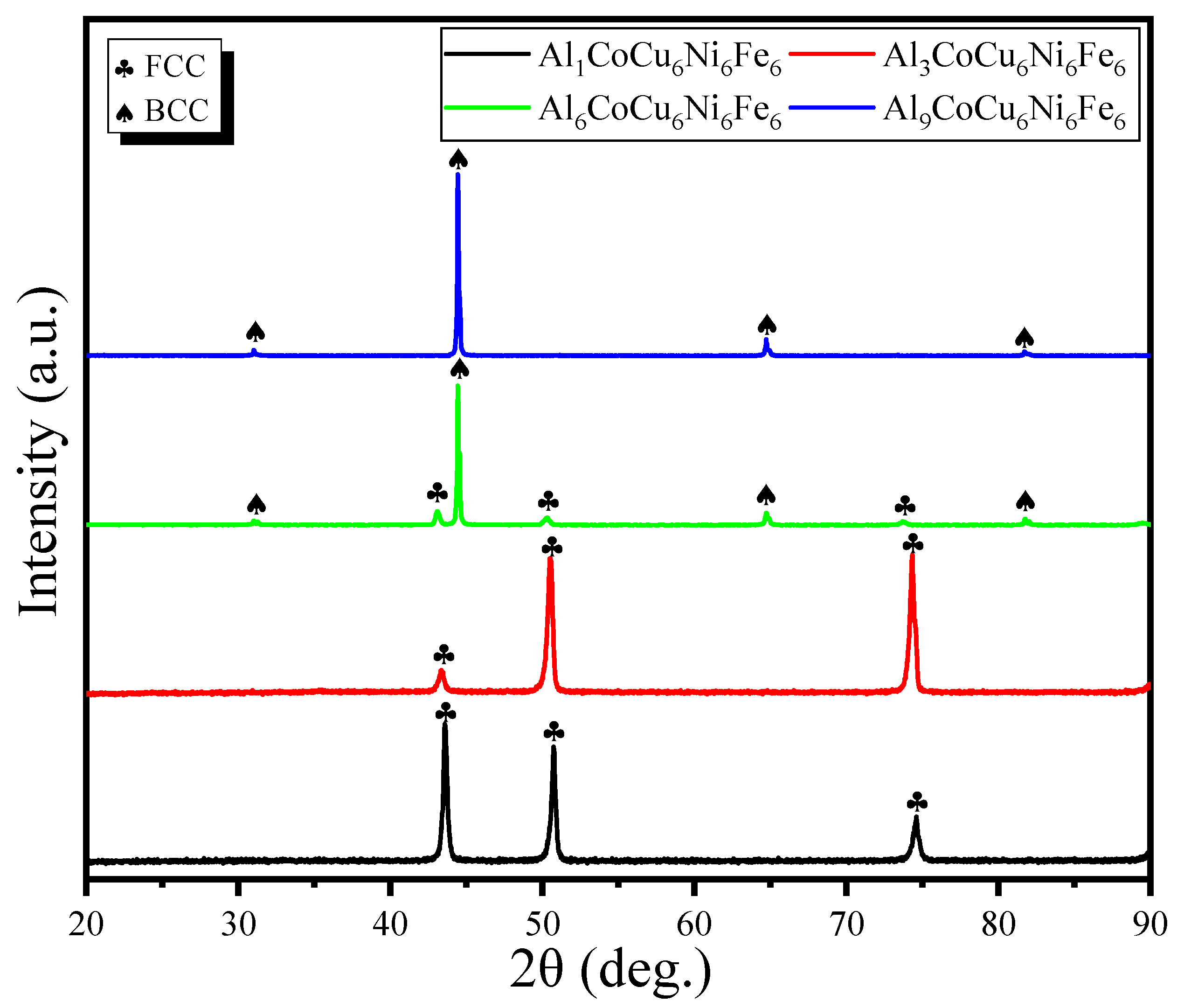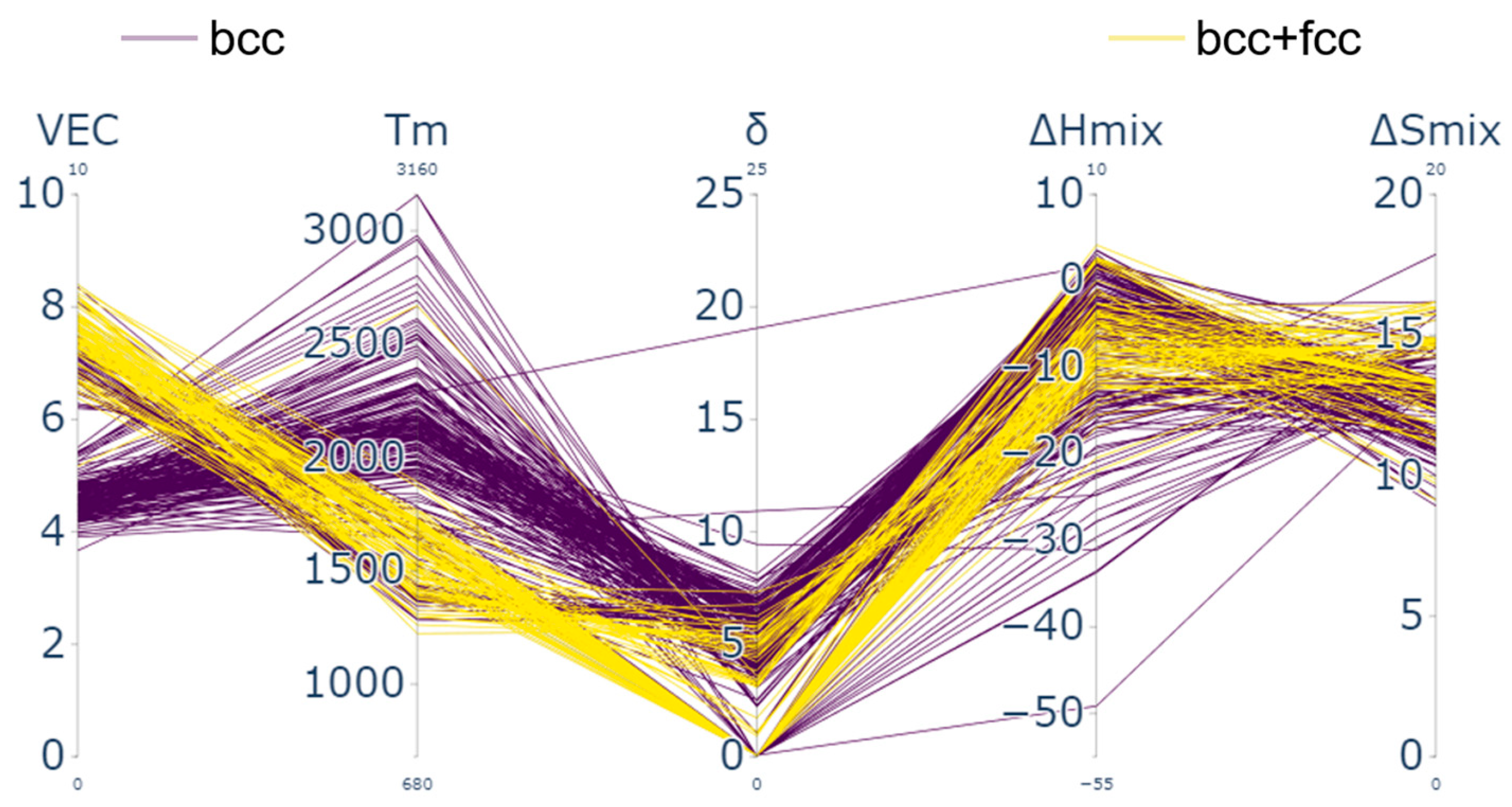Predicting New Single/Multiphase-Structure High-Entropy Alloys Using a Pattern Recognition Network
Abstract
:1. Introduction
2. Materials and Methods
3. Results and Discussion
4. Conclusions
Author Contributions
Funding
Institutional Review Board Statement
Informed Consent Statement
Data Availability Statement
Conflicts of Interest
References
- Miracle, D.B.; Senkov, O.N. A critical review of high entropy alloys and related concepts. Acta Mater. 2017, 122, 448–511. [Google Scholar] [CrossRef]
- Senkov, O.N.; Miller, J.D.; Miracle, D.B.; Woodward, C. Accelerated exploration of multi-principal element alloys with solid solution phases. Nat. Commun. 2015, 6, 6529. [Google Scholar] [CrossRef] [PubMed]
- Li, Z.; Pradeep, K.G.; Deng, Y.; Raabe, D.; Tasan, C.C. Metastable high-entropy dual-phase alloys overcome the strength–ductility trade-off. Nature 2016, 534, 227–230. [Google Scholar] [CrossRef]
- Senkov, O.N.; Wilks, G.B.; Scott, J.M.; Miracle, D.B. Mechanical properties of nbmotaw and vnbmotaw refractory high entropy alloys. Intermetallics 2011, 19, 698–706. [Google Scholar] [CrossRef]
- Wani, I.S.; Bhattacharjee, T.; Sheikh, S.; Lu, Y.P.; Chatterjee, S.; Bhattacharjee, P.P.; Guo, S.; Tsuji, N. Ultrafine-grained alcocrfeni2.1 eutectic high-entropy alloy. Mater. Res. Lett. 2016, 4, 174–179. [Google Scholar] [CrossRef]
- Gludovatz, B.; Hohenwarter, A.; Catoor, D.; Chang, E.H.; George, E.P.; Ritchie, R.O. A fracture-resistant high-entropy alloy for cryogenic applications. Science 2014, 345, 1153–1158. [Google Scholar] [CrossRef]
- Liu, K.; Wang, J.Y.; Li, X.; Qin, Q.; Wu, S.J.; Yu, H.C. A new lightweight Al2.7TiVCrCu high entropy alloy with excellent strength and toughness after homogenization treatment. Mater. Sci. Eng. A 2023, 869, 144779. [Google Scholar] [CrossRef]
- Todai, M.; Nagase, T.; Hori, T.; Matsugaki, A.; Sekita, A.; Nakano, T. Novel tinbtazrmo high-entropy alloys for metallic biomaterials. Scr. Mater. 2017, 129, 65–68. [Google Scholar] [CrossRef]
- Hori, T.; Nagase, T.; Todai, M.; Matsugaki, A.; Nakano, T. Development of non-equiatomic Ti-Nb-Ta-Zr-Mo high-entropy alloys for metallic biomaterials. Scr. Mater. 2019, 172, 83–87. [Google Scholar] [CrossRef]
- Liu, K.; Li, X.; Wang, J.Y.; Zhang, Y.; Guo, X.; Wu, S.J.; Yu, H.C. Investigation of mechanical and corrosion properties of light and high hardness cast AlTiVCrCu0.4 high entropy alloy. Mater. Charact. 2023, 200, 112878. [Google Scholar] [CrossRef]
- Jiang, H.; Han, K.; Gao, X.; Lu, Y.; Cao, Z.; Gao, M.C.; Hawk, J.A.; Li, T.J. A new strategy to design eutectic high-entropy alloys using simple mixture method. Mater. Des. 2018, 142, 101–105. [Google Scholar] [CrossRef]
- Jin, X.; Zhou, Y.; Zhang, L.; Du, X.; Li, B.S. A new pseudo binary strategy to design eutectic high entropy alloys using mixing enthalpy and valence electron concentration. Mater. Des. 2018, 143, 49–55. [Google Scholar] [CrossRef]
- Saboktakin, R.M.; Minouei, H.; Lee, B.J.; Toroghinejad, M.R.; Hong, S.I. Effects of carbon and molybdenum on the nanostructural evolution and strength/ductility trade-off in Fe40Mn40Co10Cr10 high-entropy alloys. J. Alloys Compd. 2022, 911, 165108. [Google Scholar] [CrossRef]
- Rahul, M.R.; Phanikumar, G. Design of a Seven-Component Eutectic High-Entropy Alloy. Metall. Mater. Trans. A 2019, 50, 2594–2598. [Google Scholar] [CrossRef]
- Zhang, L.; Cai, H.; Liu, J.; Ouyang, Y.F.; Peng, Q.; Du, Y. Machine learning reveals the importance of the formation enthalpy and atom-size difference in forming phases of high entropy alloys. Mater. Des. 2020, 193, 108835. [Google Scholar] [CrossRef]
- Jaiswal, U.K.; Krishna, Y.V.; Rahul, M.R.; Phanikumar, G. Machine learning-enabled identification of new medium to high entropy alloys with solid solution phases. Comput. Mater. Sci. 2021, 197, 110623. [Google Scholar] [CrossRef]
- Jiang, L.; Wang, C.S.; Fu, H.D.; Shen, J.; Zhang, Z.H.; Xie, J.X. Discovery of aluminum alloys with ultra-strength and high-toughness via a property-oriented design strategy. J. Mater. Sci. Technol. 2022, 98, 33–43. [Google Scholar] [CrossRef]
- Yegi, V.K.; Ujjawal, K.J.; Rahul, M.R. Machine learning approach to predict new multiphase high entropy alloys. Scr. Mater. 2021, 197, 113804. [Google Scholar]
- Zhang, Y.; Zhou, Y.J.; Lin, J.P.; Chen, G.L.; Liaw, P.K. Solid-Solution Phase Formation Rules for Multi-component Alloys. Adv. Eng. Mater. 2008, 10, 534–538. [Google Scholar] [CrossRef]
- Guo, S.; Ng, C.; Lu, J.; Liu, C.T. Effect of valence electron concentration on stability of fcc or bcc phase in high entropy alloys. J. Appl. Phys. 2011, 109, 103505. [Google Scholar] [CrossRef]
- Yang, X.; Zhang, Y. Prediction of high-entropy stabilized solid-solution in multi-component alloys. Mater. Chem. Phys. 2012, 132, 233–238. [Google Scholar] [CrossRef]
- Ye, Y.F.; Wang, Q.; Lu, J.; Liu, C.T.; Yang, Y. Design of high entropy alloys: A single-parameter thermodynamic rule. Scr. Mater. 2015, 104, 53–55. [Google Scholar] [CrossRef]
- Li, Y.; Guo, W.L. Machine-learning model for predicting phase formations of high-entropy alloys. Phys. Rev. Mater. 2019, 3, 095005. [Google Scholar] [CrossRef]
- Machaka, R. Machine Learning Based Prediction of Phases in High-Entropy Alloys. Comput. Mater. Sci. 2020, 188, 110244. [Google Scholar] [CrossRef]
- Gorsse, S.; Nguyen, M.H.; Senkov, O.N.; Miracle, D.B. Database on the mechanical properties of high entropy alloys and complex concentrated alloys. Data Brief 2018, 21, 2664–2678. [Google Scholar] [CrossRef] [PubMed]
- Lee, S.Y.; Byeon, S.; Kim, H.S.; Jin, H.; Lee, S. Deep learning-based phase prediction of high-entropy alloys: Optimization, generation, and explanation. Mater. Des. 2021, 197, 109260. [Google Scholar] [CrossRef]
- Zheng, T.; Hu, X.B.; He, F.; Wu, Q.F.; Han, B.; Da, C.; Li, J.J.; Wang, Z.J.; Wang, J.C.; Kai, J.; et al. Tailoring nanoprecipitates for ultra-strong high-entropy alloys via machine learning and prestrain aging. J. Mater. Sci. Technol. 2021, 69, 156–167. [Google Scholar] [CrossRef]
- Dixit, S.; Singhal, V.; Agarwal, A.; Rao, A.K.P. Multi-label phase-prediction in high-entropy-alloys using Artificial-Neural-Network. Mater. Lett. 2020, 268, 127606. [Google Scholar] [CrossRef]
- Mi, X.X.; Tian, L.J.; Tang, A.; Kang, J.; Peng, P.; She, J.; Wang, H.L.; Chen, X.H.; Pan, F.S. A reverse design model for high-performance and low-cost magnesium alloys by machine learning. Comput. Mater. Sci. 2022, 201, 110881. [Google Scholar] [CrossRef]
- Wu, C.T.; Chang, H.T.; Wu, C.Y.; Chen, S.W.; Huang, S.Y.; Huang, M.M.; Pan, Y.T.; Bradbury, P.; Chou, J.; Yen, H.W. Machine learning recommends affordable new Ti alloy with bone-like modulus. Mater. Today 2020, 34, 41–50. [Google Scholar] [CrossRef]
- Prieto, A.; Prieto, B.; Ortigosa, E.M.; Ros, E.; Pelayo, F.; Ortega, J.; Rojas, I. Neural networks: An overview of early research, current frameworks and new challenges. Neurocomputing 2016, 214, 242–268. [Google Scholar] [CrossRef]
- Basheer, I.A.; Hajmeer, M.; Microbiol, J. Artificial neural networks: Fundamentals, computing, design, and application. J. Microbiol. Methods 2000, 43, 3–31. [Google Scholar] [CrossRef] [PubMed]
- Praveen, S.; Murty, B.S.; Kottada Ravi, S. Alloying behavior in multi-component AlCoCrCuFe and NiCoCrCuFe high entropy alloys. Mater. Sci. Eng. A 2012, 534, 83–89. [Google Scholar] [CrossRef]
- Ma, Y.; Wang, Q.; Jiang, B.B.; Li, C.L.; Hao, J.M.; Li, X.N.; Dong, C.; Nieh, T.G. Controlled formation of coherent cuboidal nanoprecipitates in body-centered cubic high-entropy alloys based on Al2(Ni,Co,Fe,Cr)14 compositions. Acta Mater. 2018, 147, 213–225. [Google Scholar] [CrossRef]
- Yeh, J.W.; Chen, S.K.; Lin, S.J.; Gan, J.Y.; Chin, T.S.; Shun, T.T.; Tsau, C.H.; Chang, S.Y. Nanostructured High-Entropy Alloys with Multiple Principal Elements: Novel Alloy Design Concepts and Outcomes. Adv. Eng. Mater. 2004, 6, 299–303. [Google Scholar] [CrossRef]






| Composition | bcc | fcc | bcc+fcc | Others | Predict | Experiment | Reference |
|---|---|---|---|---|---|---|---|
| Al1CoCu6Ni6Fe6 | 0 | 0.96 | 0.04 | 0 | fcc | fcc | This work |
| Al3CoCu6Ni6Fe6 | 0 | 0.87 | 0.12 | 0.01 | fcc | fcc | This work |
| Al6CoCu6Ni6Fe6 | 0.01 | 0.42 | 0.56 | 0.01 | bcc+fcc | bcc+fcc | This Work |
| Al9CoCu6Ni6Fe6 | 0.01 | 0.13 | 0.86 | 0 | bcc+fcc | bcc | This Work |
| Al0CoCrCuNiFe | 0.01 | 0.89 | 0.08 | 0.02 | fcc | fcc | [35] |
| Al0.3CoCrCuNiFe | 0.02 | 0.58 | 0.33 | 0.07 | fcc | fcc | [35] |
| Al0.5CoCrCuNiFe | 0.02 | 0.33 | 0.54 | 0.11 | bcc+fcc | fcc | [35] |
| Al0.8CoCrCuNiFe | 0.02 | 0.11 | 0.73 | 0.13 | bcc+fcc | bcc+fcc | [35] |
| Al1CoCrCuNiFe | 0.02 | 0.06 | 0.80 | 0.12 | bcc+fcc | bcc+fcc | [35] |
| Al1.3CoCrCuNiFe | 0.02 | 0.02 | 0.86 | 0.10 | bcc+fcc | bcc+fcc | [35] |
| Al1.5CoCrCuNiFe | 0.02 | 0.01 | 0.89 | 0.08 | bcc+fcc | bcc+fcc | [35] |
| Al1.8CoCrCuNiFe | 0.02 | 0.01 | 0.91 | 0.06 | bcc+fcc | bcc+fcc | [35] |
| Al2CoCrCuNiFe | 0.01 | 0.01 | 0.93 | 0.05 | bcc+fcc | bcc+fcc | [35] |
| Al2.3CoCrCuNiFe | 0.01 | 0.01 | 0.94 | 0.04 | bcc+fcc | bcc+fcc | [35] |
| Al2.5CoCrCuNiFe | 0.01 | 0.01 | 0.95 | 0.03 | bcc+fcc | bcc+fcc | [35] |
| Al2.8CoCrCuNiFe | 0.01 | 0 | 0.96 | 0.03 | bcc+fcc | bcc | [35] |
| Al3CoCrCuNiFe | 0.01 | 0.01 | 0.96 | 0.02 | bcc+fcc | bcc | [35] |
Disclaimer/Publisher’s Note: The statements, opinions and data contained in all publications are solely those of the individual author(s) and contributor(s) and not of MDPI and/or the editor(s). MDPI and/or the editor(s) disclaim responsibility for any injury to people or property resulting from any ideas, methods, instructions or products referred to in the content. |
© 2024 by the authors. Licensee MDPI, Basel, Switzerland. This article is an open access article distributed under the terms and conditions of the Creative Commons Attribution (CC BY) license (https://creativecommons.org/licenses/by/4.0/).
Share and Cite
Wang, F.; Wang, J.; Wang, J.; Wu, R.; Liu, K. Predicting New Single/Multiphase-Structure High-Entropy Alloys Using a Pattern Recognition Network. Coatings 2024, 14, 690. https://doi.org/10.3390/coatings14060690
Wang F, Wang J, Wang J, Wu R, Liu K. Predicting New Single/Multiphase-Structure High-Entropy Alloys Using a Pattern Recognition Network. Coatings. 2024; 14(6):690. https://doi.org/10.3390/coatings14060690
Chicago/Turabian StyleWang, Fang, Jiahao Wang, Jiayu Wang, Ruirui Wu, and Ke Liu. 2024. "Predicting New Single/Multiphase-Structure High-Entropy Alloys Using a Pattern Recognition Network" Coatings 14, no. 6: 690. https://doi.org/10.3390/coatings14060690




